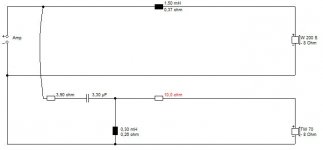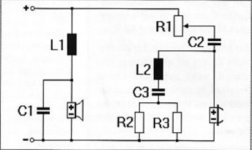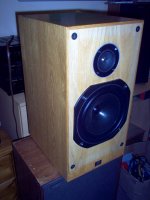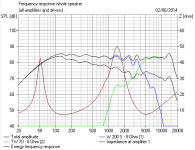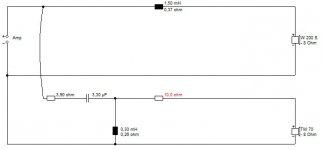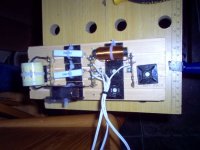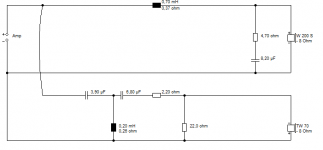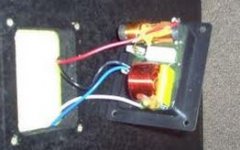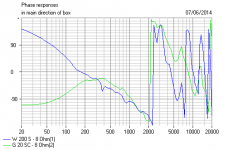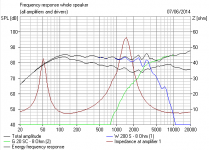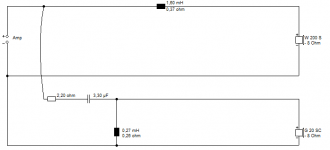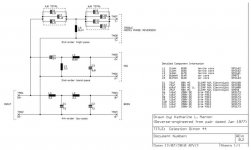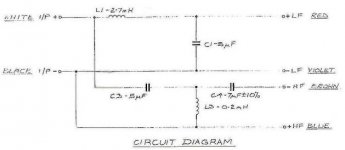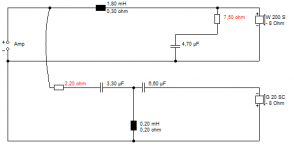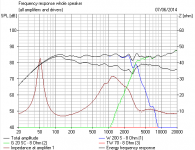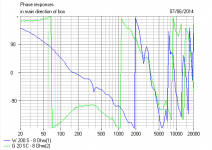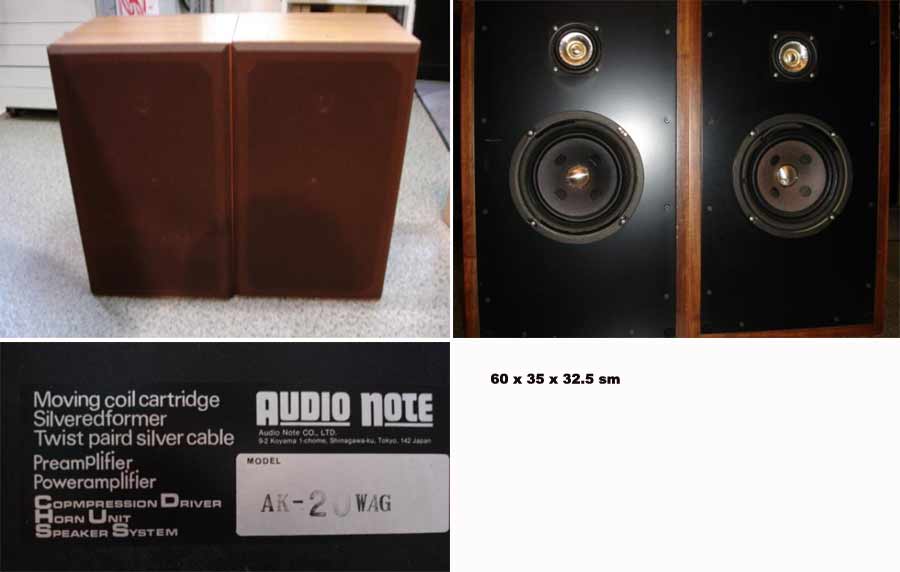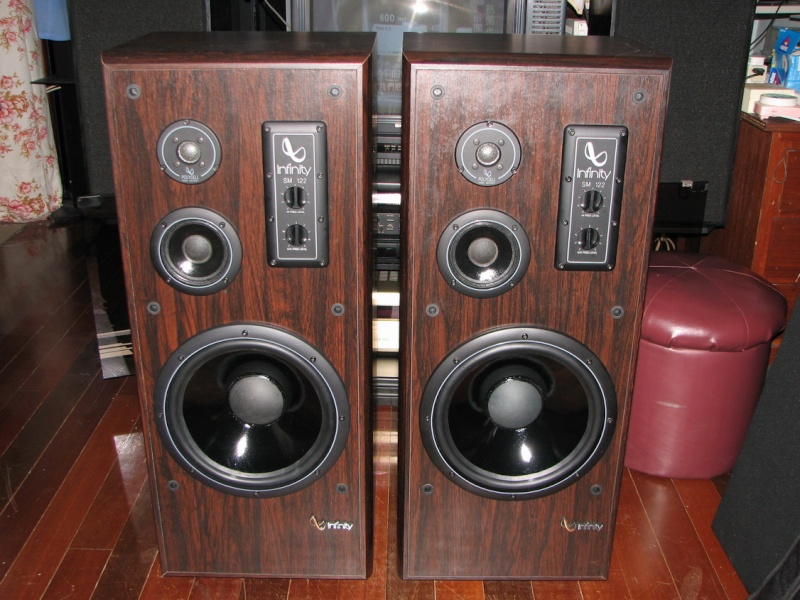Hi,
I am thinking about building a 2 way design similar to Audio Note or Snell E. I have broken down an old pair of Infinity SM122s that were given to me. I was specifically wondering if the adjustable crossover would be worth using? It is one of those that has the knob so that you can adjust the crossover point (I think). I am assuming that the drivers are not appropriate for what I am looking to do. They have a reputation for being rock and roll speakers.
Also, are there any diy designs like the Snell or Audio Notes? I know that they sell the kits for the Audio Notes but they seem a bit expensive. I want to build something very transparent, musical, etc. I mostly listen to acoustic jazz and vocals.
Thanks
I am thinking about building a 2 way design similar to Audio Note or Snell E. I have broken down an old pair of Infinity SM122s that were given to me. I was specifically wondering if the adjustable crossover would be worth using? It is one of those that has the knob so that you can adjust the crossover point (I think). I am assuming that the drivers are not appropriate for what I am looking to do. They have a reputation for being rock and roll speakers.
Also, are there any diy designs like the Snell or Audio Notes? I know that they sell the kits for the Audio Notes but they seem a bit expensive. I want to build something very transparent, musical, etc. I mostly listen to acoustic jazz and vocals.
Thanks
You won't be able to reuse that crossover at all. But 8" bass plus tweeter is a very easy speaker to get right.
Troels Gravesen likes this one a lot: TQWT-
Quite a hard build though. I was impressed by this WLM La Scala design:
That is a Visaton W200S-8 bass and TW70 cone tweeter. The filter below will work well enough with it.
You could also probably use that Phenolic Ring Tweeter at Parts Express. The main trick is to get a well behaved bass like this:
H1471-08 CA22RNY
Troels Gravesen likes this one a lot: TQWT-
Quite a hard build though. I was impressed by this WLM La Scala design:
An externally hosted image should be here but it was not working when we last tested it.
That is a Visaton W200S-8 bass and TW70 cone tweeter. The filter below will work well enough with it.
You could also probably use that Phenolic Ring Tweeter at Parts Express. The main trick is to get a well behaved bass like this:
H1471-08 CA22RNY
Attachments
If you want to build a 2-way design (yourself) like the AN's you have a long way in front of you, both in years andHi,
I am thinking about building a 2 way design similar to Audio Note or Snell E. I have broken down an old pair of Infinity SM122s that were given to me. I was specifically wondering if the adjustable crossover would be worth using? It is one of those that has the knob so that you can adjust the crossover point (I think). I am assuming that the drivers are not appropriate for what I am looking to do. They have a reputation for being rock and roll speakers.
Also, are there any diy designs like the Snell or Audio Notes? I know that they sell the kits for the Audio Notes but they seem a bit expensive. I want to build something very transparent, musical, etc. I mostly listen to acoustic jazz and vocals.
Thanks



StereoTimes -- Audio Note AN-E SEC Silver Loudspeaker
Snell Type E/III loudspeaker | Stereophile.com
Snell
http://www.audionote.co.uk/articles/reviews/PDF_HT05_Audio_Note_engl.pdf
Look at my previous design for the 8" + tweeter with a variable attenuator:
http://www.diyaudio.com/forums/mult...elf-speakers-my-requirements.html#post3933264
You have many exotics well priced but I doubt that you would spend that amount of money in drivers (example below).
SEAS Exotic T35 X3-06 Alnico
So if you don't build - You didn't build that!...(mime)
Eton S7, Symphony 7" 2-Way Kit, Pair kit1 (price/pair)
Seas A26 10" 2-way Kit, Pair (based on the Dynaco) kit2
with nice Seas Prestige A26RE4 10"
http://www.diyaudio.com/forums/multi-way/195168-dynaco-clone-seas-exotic-t35-tweeter.html
Other interesting drivers:
SEAS CA21REX
SEAS W22EX-001
SEAS U22REX/P-SL (H1659-08) 8" Woven
Vifa 21 WN 340/8
DAVIS 20MC8
Aurum Cantus AC200/50C2C 8"
AUDAX AT210Z0
Scan Speak 21W/8554
Midrange distortion test (LINKWITZ)
Tweeters, others:
Monacor DT 300
Tonegen/Foster (Tonegen was a supplier to Infinity, and others, merged with Foster in Japan and production was transferred to Taiwan. In 2005 production moved to China.) link
Tonegen 94C70DS-00HD
Tonegen 94C7DDS00HD (variant)
Seas T25CF001 E0006-06 Tweeter Madisound
Seas Millennium T25CF002 - E0011
SEAS Prestige 27TDC (H1149) no ferrro
SEAS Prestige 27TFFC (H0881)
AN kits
AN kits2
Attachments
WLM reviewers say it's a 1.5kHz crossover (Zobel on the bass?) with first order tweeter, but I've never heard a speaker like that which actually sounds good. So I just go with the woofers natural rolloff around 3.5kHz, which is what Troels does too. Below.
Cabinet is just whatever you want really, between 30 and 60 litres. I think a Spendor lossy type would work well here: Spendor BC1. Removeable baffle is quite a good idea for future updates.
Drive units are a moveable feast too, as Inductor says. The SEAS U22REX/P would be a VERY nice one to use IMO. But Visaton give you some tunings: W 200 S - 8 Ohm
Cone tweeters are the key to a nice sound IMO. I've tried soft domes and not liked them so much, they spit and sizzle. Cheap as chips too. I'm using a REALLY CHEAP £6 Monacor HT22/8 here which is a bit flatter than the TW70.
The filter I gave is easily adjusted to taste. A smaller 1mH coil will give less bass for instance and might be right for a big reflex, the 10 ohm adjusts treble level. Try it in Boxsim. How easy is that? And it sounds very good indeed.
Cabinet is just whatever you want really, between 30 and 60 litres. I think a Spendor lossy type would work well here: Spendor BC1. Removeable baffle is quite a good idea for future updates.
Drive units are a moveable feast too, as Inductor says. The SEAS U22REX/P would be a VERY nice one to use IMO. But Visaton give you some tunings: W 200 S - 8 Ohm
Cone tweeters are the key to a nice sound IMO. I've tried soft domes and not liked them so much, they spit and sizzle. Cheap as chips too. I'm using a REALLY CHEAP £6 Monacor HT22/8 here which is a bit flatter than the TW70.
The filter I gave is easily adjusted to taste. A smaller 1mH coil will give less bass for instance and might be right for a big reflex, the 10 ohm adjusts treble level. Try it in Boxsim. How easy is that? And it sounds very good indeed.
Attachments
Cone tweeters are the key to a nice sound IMO. I've tried soft
domes and not liked them so much, they spit and sizzle. Cheap
as chips too. I'm using a REALLY CHEAP £6 Monacor HT22/8
here which is a bit flatter than the TW70.
Remembering your post about Robin Marshall Interview, I know
now where your appreciation of cone tweeters may be coming from.
Right or wrong?
I can't seem to remember you saying anything about owning measuring
equipment. Using any ? I am asking that because I find your statement
of dome tweeters not sounding right a bit uncommon. I have to say that
I have never come accross a dome, usual or inverted one, not sounding
nice or right. Not saying there weren't any differences.
Lojzek, I've been listening to good speakers for 40 years, and I'm pretty good at picking out frequency response, and phase alignment and the reflex or closed box sound. 
I can usually tune a crossover by ear too, because I know what does what. I have a multimeter and a tone generator, but that's it really.
Soft domes sound OK when you are fresh, because your ear can compensate. But when you are tired, they sound terrible IMO. There are some designs like the Vifa XT25 and SB Acoustics which fix the 7kHz resonance problems at the centre of the dome. Think about it, why is a cone good for bassmids, but not for tweeters? Actually the only thing soft domes have going for them is good dispersion.
These days, I think that spherical tweeters and spherical dustcaps on bass units are just bad news. The mathematical basis is to be found at 33 minutes into this lecture: Lecture 9 | String Theory and M-Theory - YouTube
Waves behave badly on a sphere at high frequency. To get back on-topic, once you have some drive units which play nicely together, and a cabinet which works, the crossover is easily modified. I have done some more complex ones with success, but this simple filter is an easy start. It's up to you how much you want to pay for a bass unit. Obviously the better ones cost more.
I can usually tune a crossover by ear too, because I know what does what. I have a multimeter and a tone generator, but that's it really.
Soft domes sound OK when you are fresh, because your ear can compensate. But when you are tired, they sound terrible IMO. There are some designs like the Vifa XT25 and SB Acoustics which fix the 7kHz resonance problems at the centre of the dome. Think about it, why is a cone good for bassmids, but not for tweeters? Actually the only thing soft domes have going for them is good dispersion.
These days, I think that spherical tweeters and spherical dustcaps on bass units are just bad news. The mathematical basis is to be found at 33 minutes into this lecture: Lecture 9 | String Theory and M-Theory - YouTube
Waves behave badly on a sphere at high frequency. To get back on-topic, once you have some drive units which play nicely together, and a cabinet which works, the crossover is easily modified. I have done some more complex ones with success, but this simple filter is an easy start. It's up to you how much you want to pay for a bass unit. Obviously the better ones cost more.
Because there's many variations on this theme, here's a Sony E44 which I gave a better crossover to than the original mere 2.2uF on the tweeter.
Nice eminence style woofer with cloth surround and transparent cloth dustcap. Mylar cone tweeter. Just up my street, eh?
It sounds terrific.
An externally hosted image should be here but it was not working when we last tested it.
Nice eminence style woofer with cloth surround and transparent cloth dustcap. Mylar cone tweeter. Just up my street, eh?
It sounds terrific.
Attachments
Lojzek, I've been listening to good speakers for 40 years, and I'm pretty good at picking out frequency response, and phase alignment and the reflex or closed box sound.
I can usually tune a crossover by ear too, because I know what does what. I have a multimeter and a tone generator, but that's it really.
That does explain a lot then. Guessing , not measuring.
A very sarcastic and unhelpful comment really, David. I did more actual measuring with these MA R300-MD speakers than anybody else. I used a £70 mH and uF multimeter to check the coil and cap values for one thing.That does explain a lot then. Guessing , not measuring.
An externally hosted image should be here but it was not working when we last tested it.
This is one of many variations on a theme that Robin Marshall did for Monitor Audio. The R252 and R352 were similar except for a soft dome tweeter, rather than the later 88dB Metal Dome SEAS 19TAF/G used here.
Some people here may remember that the ferrofluid in the tweeters was dried out in these speakers when I bought them second hand.
The actual response of the filter is quite rough and ready, and you can see that there is a case for fitting a 7.5R/0.68uF Zobel across the tweeter to reduce the bright top end. That is not guesswork, because you can look up the 88dB SEAS tweeter Re and Le and calculate the Zobel. I would say it's immaterial whether it's the double magnet version or not, but the only simple option to change treble level is to adjust the 2.2R resistor.
H0532-08 19TAFD/G
The phase and frequency response is not going to improve with more accurate simulations despite me modelling it with a different 88dB Visaton tweeter. It's just how this simple filter works with 8" bass because it has some time alignment issues on a flat baffle.
The real thing you gain from this is an understanding of how the filter works. To do a better filter, you need to look at some KEF 2nd/3rd order designs here, which wire in negative polarity. But you will notice I don't recommend that for the inexperienced because you need to understand how they work to tune them by ear.
Attachments
I'm not hurting at all. My ears are my measurement ultimately.The truth hurts. I wasn't the one that admitted to not measuring hardly anything. If you just spent a little money on a measurement mic/preamp and used plenty of free software, you could design and modify speakers so much easily and much better also.
I have very little interest in setting up a science laboratory, and nor do most people either IMO. That's not what I do. What I do very well, is work out what combinations of drivers and filters work well and explain it in simple terms.
http://www.diyaudio.com/forums/multi-way/147632-classic-monitor-designs-13.html
I have an interest in cabinets too:
http://www.diyaudio.com/forums/multi-way/223174-interesting-read-i-found-lossy-cabinet-designs-harbeth.html#post3234256
I would suggest to you that you tell us about some of your own designs, rather than pick holes in my deceptively simple methods. Because if you can't explain it simply, you don't understand it IMO.
Hi. Thanks for all of the discussion. I would like to use this building process to learn about crossovers and tuning by ear so starting simple would be great.
How simple does something like this look? Is this a fullrange driver with tweeter? or is this just an 8" woofer with tweeter?
https://www.youtube.com/watch?v=Iho8C16664o
I am sure that it would be difficult without actually seeing the crossover...
How simple does something like this look? Is this a fullrange driver with tweeter? or is this just an 8" woofer with tweeter?
https://www.youtube.com/watch?v=Iho8C16664o
I am sure that it would be difficult without actually seeing the crossover...
Last edited:
@System7
Yeah sure pal. That mic/preamp might set you back a whopping $200 or less , hardly a "science laboratory"
Are your ears calibrated? Ever had one of your modifications/designs measured to see just how well your ears work? Uh huh.
Oh I plan on showing you and others a modification soon using real measurements, not guess work.
"Because if you can't explain it simply, you don't understand it IMO"
Simply sometimes gets you nowhere. real understanding involves digging into the why and how and using all the resources available to get a really good result, you know like using measurements
Do you think that the majority of modern speaker designs out there rely upon their ears only to build them? Wake up and join the 21st century.
Yeah sure pal. That mic/preamp might set you back a whopping $200 or less , hardly a "science laboratory"
Are your ears calibrated? Ever had one of your modifications/designs measured to see just how well your ears work? Uh huh.
Oh I plan on showing you and others a modification soon using real measurements, not guess work.
"Because if you can't explain it simply, you don't understand it IMO"
Simply sometimes gets you nowhere. real understanding involves digging into the why and how and using all the resources available to get a really good result, you know like using measurements
Do you think that the majority of modern speaker designs out there rely upon their ears only to build them? Wake up and join the 21st century.
That sort of speaker is probably almost unfiltered. You'll notice that people always demonstrate with very simple undemanding program material, what Lynn Olson calls "Little Girl With A Guitar" material. That sort of thing sounds very bad with orchestra or rock, for instance, because it distorts too much. For sure, you can never get it quite right, and people then start fiddling with cables and amps to try and rescue them.Hi. Thanks for all of the discussion. I would like to use this building process to learn about crossovers and tuning by ear so starting simple would be great.
How simple does something like this look? Is this a fullrange driver with tweeter? or is this just an 8" woofer with tweeter?
https://www.youtube.com/watch?v=Iho8C16664o
I am sure that it would be difficult without actually seeing the crossover...
For all that, such simple speakers have very good and fast time response. But definitely not an all-rounder.
Possibly the best popular speaker of this type is the SEAS A26. A 10" paper bass has very good natural rolloff and it ought to play Jazz very well.
My Sony E44 were on much the same lines originally with a simple 2.2uF capacitor.
An externally hosted image should be here but it was not working when we last tested it.
I suppose it would be interesting to put them back to the simple original, now that I have grown used to the more sophisticated KEF-style crossover.
When you do simple filters, you have to pay great attention to the drive units being well-behaved. Like the SEAS CA22RNY which I picked out earlier.
H1471-08 CA22RNY
All that needs is a bit of downward slope from a 1-1.5mH coil. You'd then cross it over at 3.5kHz. I think you can see that.
Last edited:
Is this a fullrange driver with tweeter? or is this just an 8" woofer with tweeter?
Rather an 8" woofer and a fullrange driver (called FAST: Fullrange and Subwoofer Technology).
The white driver might be a Fostex FE83En:
FE Series : Speaker Components : Fostex
Yes indeed. FAST. planet10 aka Dave always says this is a good way to do things. Maybe it's down to the cone fullrange at the top? The fullrange is also spared excessive bass excursion. 
The best sounding conventional speaker is probably a 3 way. Meet the Celestion Ditton 44. Bit of a classic that I have lying around and a useful reference sound:
You get a deep bass, fast 6" midrange with good dispersion and a HF2000 mylar tweeter that picks it up at 3.5kHz. Celestion never used the downward sloping BBC dip, so they are quite bright sounding.
What we can learn from it is how to do a third order tweeter filter. It's not a million miles away from the KEF Celeste III too, which used a regular 8" paper bass. Dissi dug that one up.
You have to make the 8" bass second order with third order tweeter here, because of the error in time alignment. You also have to damp the bass shunt to avoid a lift in response and align phase. But it will have a much cleaner sound (less cone breakup) than the simple filter we have been talking about. Tweeter level is adjusted with a single resistor. The miracle of this filter is that it aligns phase better at crossover than any other design I can think of. But I would caution that you will need to work quite hard to tune it by ear.
The best sounding conventional speaker is probably a 3 way. Meet the Celestion Ditton 44. Bit of a classic that I have lying around and a useful reference sound:
An externally hosted image should be here but it was not working when we last tested it.
You get a deep bass, fast 6" midrange with good dispersion and a HF2000 mylar tweeter that picks it up at 3.5kHz. Celestion never used the downward sloping BBC dip, so they are quite bright sounding.
What we can learn from it is how to do a third order tweeter filter. It's not a million miles away from the KEF Celeste III too, which used a regular 8" paper bass. Dissi dug that one up.
You have to make the 8" bass second order with third order tweeter here, because of the error in time alignment. You also have to damp the bass shunt to avoid a lift in response and align phase. But it will have a much cleaner sound (less cone breakup) than the simple filter we have been talking about. Tweeter level is adjusted with a single resistor. The miracle of this filter is that it aligns phase better at crossover than any other design I can think of. But I would caution that you will need to work quite hard to tune it by ear.
Attachments
- Status
- This old topic is closed. If you want to reopen this topic, contact a moderator using the "Report Post" button.
- Home
- Loudspeakers
- Multi-Way
- Question about reusing crossover for 2 way
